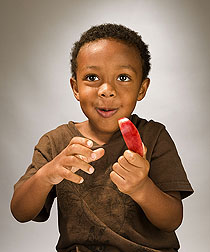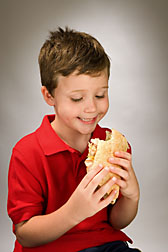Kids, FastFood, & Obesity
Menu Reviews From a Houston Pediatrician
America’s kids love those special “combo” meals that fast-food restaurants create specifically for these young customers. Bagged or colorfully boxed, the convenient, enjoyable meals often include a toy, something that can make the meal even more delightful for a child.
Do these fast-food restaurants have combo meals that are healthy for kids?
In some cases, yes. But healthy combo meals for youngsters are not common. That’s according to pediatrician and researcher Jason A. Mendoza, M.D. “Parents may have to check the menu at more than just one restaurant to find healthy choices,” he says.
Mendoza is one of four researchers who teamed up to scrutinize the nutritional quality of fast-food kids’ meals. He’s based at the Children’s Nutrition Research Center at Baylor College of Medicine in Houston, Texas. ARS funds the center in cooperation with the college and Texas Children’s Hospital.
For this first-of-its-kind study, the team zeroed in on kids’ meals served at 10 well-known regional or national fast-food restaurant chains in Houston.
Most Meals Get a Failing Grade
|
|
Mendoza and co-investigators found that only 3 percent of the kids’ meals offered at these eateries met seven key standards set by the National School Lunch Program for meals intended for children in kindergarten through third grade. These “best-choice” meals were those that featured a deli-style sandwich—turkey, ham, roast beef, or tuna—combined with a fruit, such as apple slices or raisins, or a veggie that wasn’t fried, and low-fat milk as the beverage.
Also making the grade: a kids’ meal that featured a plain hamburger, fruit as a side, and low-fat milk as the included beverage.
These meals met or exceeded the School Lunch minimums for protein, vitamins A and C, and iron and calcium, and didn’t exceed the maximum recommended levels for total fat or saturated fat, says Mendoza.
But not every deli-style sandwich meal made the grade. One deli-sandwich combo that flunked, for example, included mayonnaise, oil splashed on the sandwich for extra flavor, a nonfruit side such as fries, and juice, tea, or a sweetened beverage, such as a soda.
Where did the meal go wrong?
Among other failings, the mayo and oil made the meal too high in fat, and the lack of milk made it too low in calcium.
Of the meals that failed to meet the School Lunch guidelines, more than 65 percent had too much fat. What’s more, 75 percent had too little calcium, 82 percent had too little iron, and 85 percent had too little vitamin A.
There’s another way to look at the combo meals’ report card—dietary energy density. Simply put, energy density is calories divided by the serving’s weight in grams.
“Energy density isn’t yet a term that everybody knows,” says Mendoza, But, he points out, several leading entities, such as the World Health Organization, and an Expert Committee convened by the American Medical Association, have recommended restricting children’s consumption of energy-dense foods as a strategy to prevent and treat obesity.
The average energy density of the fast-food meals that did not meet the School Lunch standards was 2.3 calories per gram compared to only 1.5 calories per gram for the meals that met the standards.
Mendoza says that the study results are relevant nationally. That’s not only because of Houston’s size—the city is the fourth largest in the United States—but also because the restaurants there include 10 of the nation’s 13 regional and national fast-food chains that sell kids’ meals.
For this research, Mendoza teamed with Sharon L. Hoerr, nutrition professor at Michigan State University-East Lansing, and two co-investigators who were formerly with the Children’s Nutrition Research Center—Eugenia T. Goh, now with the Children’s Medical Center-Dallas, and study leader and economist Sharon I. O’ Donnell, currently at the U.S. Census Bureau.
|
|
National Trends Suggest Need For Study
The researchers’ interest in conducting a science-based assessment was spurred by two national trends: the increase in childhood obesity and the increase in the number of meals eaten away from home. More than 16 percent of children and adolescents in the United States are overweight. The 2005 Dietary Guidelines for Americans describes this as a doubling of the estimated incidence of overweight among children and a tripling of the rate among adolescents in the past two decades.
Pediatricians and other healthcare professionals find the child-obesity trend alarming because of its potential consequences later in life. For example, overweight and obesity may lead to a higher risk of type 2 diabetes, cardiovascular disease, and certain kinds of cancer or even a higher risk of premature death.
Just as obesity rates continue to trend upward, so has—in general—the number of meals eaten away from home, growing from 20 percent in the late 1970s to more than 30 percent today, according to U.S. Department of Agriculture food surveys of Americans. In particular, 25 percent of U.S. 4- to 8-year-olds will, on a typical day, eat fast food.
The fast-food study was published in a 2008 issue of the American Journal of Clinical Nutrition.—By Marcia Wood, Agricultural Research Service Information Staff.
This research is part of Human Nutrition, an ARS national program (#107) described on the World Wide Web at www.nps.usda.gov.
Jason A. Mendoza is with the USDA-ARS Children’s Nutrition Research Center, 1100 Bates St., Houston, TX 77030; phone (713) 798-7055, fax (713) 798-7098.
"Kids, Fast Food, & Obesity: Menu Reviews From a Houston Pediatrician" was published in the October 2009 issue of Agricultural Research magazine.










